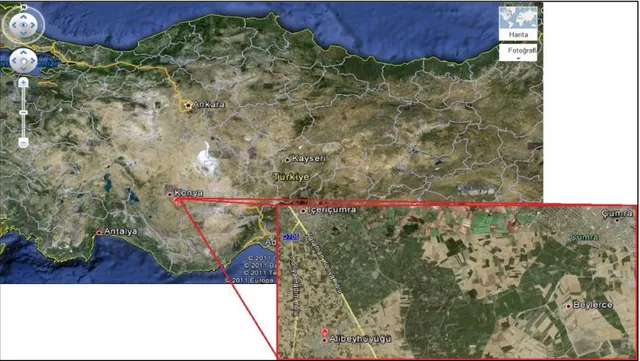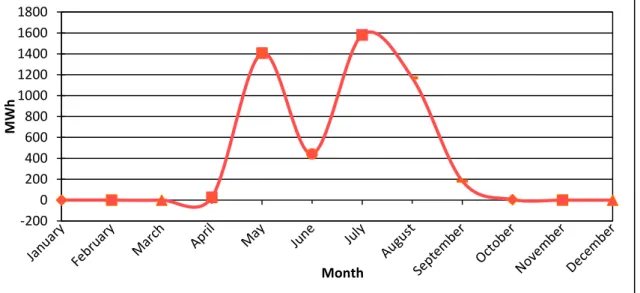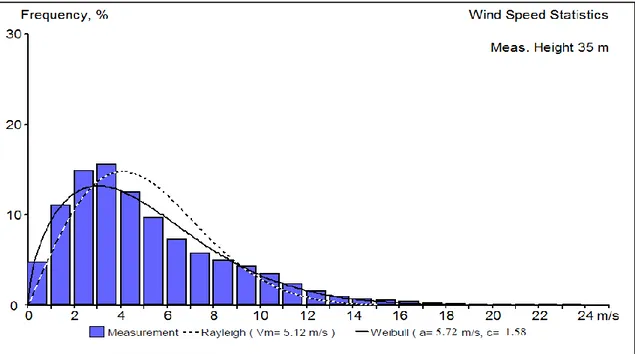Complementarity of wind power and pumped hydro energy storage
systems – a case study: meeting the electrical energy demand of rural
irrigation pumps of Cumra, Alibeyhuyugu
FARUK KÖSEA, MEHMET NUMAN KAYA1B
ASelçuk University, Department of Mechanical Engineering, Aladdin Keykubat Campus, Konya BKaramanoğlu Mehmetbey University, Department of Mechanical Engineering, Yunus Emre Campus, Karaman
fkose@selcuk.edu.tr, mnumankaya@kmu.edu.tr
Abstract: Energy has been one of the most important components for human beings to have a
comfortable life. Much has been discussed about energy production methods since energy is such a remarkable topic. Renewable energy sources have become more popular in recent years because of the limited amount of fossil fuels. However, the dependency of renewable energy sources on the weather and climate, pointed people to search energy storage methods to supply firm power. Especially storing wind energy is one of the most popular topics for researchers. Pumped-hydro, compressed air and battery energy storage systems are the bulk energy storage systems to store wind energy. Pumped-hydro energy storage (PHES) systems are a step ahead among other bulk energy storage methods because they are more efficient and they have higher storage capacities. In this study, we have designed and analyzed a wind-pumped hydro hybrid energy supply system to meet the electrical energy demand of water pumps used for rural irrigation in Cumra, Alibeyhüyüğü and sell the excess energy to the government or local consumers. ALWIN program is used for annual energy generation prediction.
Keywords: Pumped hydro, energy storage, hybrid energy systems, wind energy, turbine water
supply, rural, irrigation
1 INTRODUCTION
The number of studies about using renewable energy sources (RES) more efficiently increases day by day. Renewable energy sources are important especially for the countries which pay a great amount of money for energy import. Turkey, that imports more than half of its energy requirement, is one of them. The Turkish government has seen renewable power production as a solution to decrease energy import and developed various programs to encourage the use of Renewable energy sources. As Turkish minister of energy declared, the Turkey’s goal is to produce 30 % of the electricity from the renewable energy sources by the end of 2023. Hydro power will play an important goal to achieve this goal. Turkey has a great hydroelectric potential, which is 140 GWh/year. However, only 20 % of this potential is used in Turkey while developing countries use approximately 60 % of their hydroelectric potential [1]. Turkey has total installed hydroelectric power potential of 15,830 MW and 51,795 GWh of electricity has been produced from the HEPPs in Turkey by the end of 2010[2]. The economical installed hydroelectric power capacity will be 44,200 MW once the new HEPPs are constructed in Turkey by the end of 2023 [3]. Also investments on wind energy increase quickly in Turkey since wind energy is a clean, affordable and abundant energy source. Total wind power plant capacity has reached 1478 MW in Turkey according to the Electrical Power Resources Survey and Development Administration [4]. The dependency of renewable energy sources on the weather and climate pointed researchers to design hybrid systems such as wind/hydro hybrid power generation system to supply firm power.
Pumped hydro energy storage (PHES) systems are preferred among bulk energy storage systems because they are more efficient and they have higher storage capacities. These systems consist of four main components which are upper reservoir, lower reservoir, hydro turbines and hydro pumps. When there is low energy demand and excess electrical energy, water is pumped from the lower reservoir to upper reservoir and when there is high energy demand, water is driven from the upper reservoir to lower reservoir to generate electricity in these systems.
The studies on wind power and pumped hydro hybrid power generation systems are popular in the literature since firm power supply from RESs is an important topic. Dursun B. and Alboyacı B. Studied about the contribution of wind-hydro pumped storage systems in meeting Turkey’s electric energy demand and specified that Wind/hydro solutions not only guarantee the continuous capability to cover the electricity demand of local grid, but minimizes the dependency on imported fuel and also reduces the negative resulting from the usage of fossil fuels [5]. Dursun and his colleagues studied about finding an optimal wind-hydro solution for the Marmara region of Turkey to meet electricity demand and specified that energy demand fulfillment of the Marmara region can be efficiently realized by a wind-hydro power system at a very low and reasonable energy cost [6]. Jaramillo and his colleagues defined in their study that it is possible to guarantee continuous availability feature of firm power by means of the hydropower used to compensate for wind fluctuations [7]. Castronuovo and Lopes studied about Optimal operation and hydro storage sizing of a wind–hydro power plant and found out that yearly 11.91 % profit can be obtained by purchasing energy in low demand periods and selling in high demand periods in Portugal [8]. Denault and his colleagues specified that any proportion of wind up to 30 % improves the production deficit risk profile of an all-hydro system [9]. Vieira and Ramos studied about
In this study, we have designed and analyzed a wind-pumped hydro hybrid energy supply system to meet the electrical energy demand of water pumps used for rural irrigation in Cumra, Alibeyhuyugu and sell the excess energy to the government. Long term measurement data are used in the study.
2 ALIBEYHUYUGU AND ABH IRRIGATION CORPORATION
Alibeyhuyugu is a small town located in Cumra, Konya that is 9 km distant from Cumra district and 41 km distant from Konya. The population is nearly 6000 and the main source of live hood is the agriculture of the small town. The region's economy relies mostly on agriculture and stockbreeding. Mostly corn crops and different types of vegetables are planted in the region. The location of the Alibeyhuyugu on the map is shown in Fig. 1 [11].
Fig. 1 Alibeyhuyugu, Cumra, Konya
Alibeyhuyugu (ABH) Irrigation Corporation is a co-op that is established to supply water demand of Alibeyhuyugu for rural irrigation. Today, the corporation has 118 irrigation wells with submerged pumps and the corporation sells irrigation water to the farmers for a reasonable price. Irrigation is supplied through submerged irrigation pumps that have input powers between 45 and 110 kW.
Annual mean energy consumption of irrigation pumps is approximately 4,800 MWh. However, a small capacity increment is planned in upcoming years. In this study, we used the data saved in 2010.
Pumps are in operation only in six months of the year. This period is called the irrigation period that begins in April and ends in October. Monthly energy consumption of irrigation pumps in 2010 is shown in Fig. 2.
Fig. 2 Monthly energy consumption of irrigation pumps in 2010
As seen in Fig. 2, maximum values are obtained in the months May, July and August with 1,407 MWh, 1,581 MWh and 1,170 MWh energy consumptions, respectively. Monthly mean energy consumption is 802.6 MWh and daily mean energy consumption is 13.19 MWh if we consider 6 months in which irrigation pumps are in operation.
Wind Characteristic of the Region 2.1
Wind climate data have been measured since 2006 with the help of a wind pole in the region. In this paper, we used the data for 2007 because wind speed data of this year likely represents mean values. Monthly mean wind speed values are shown in Fig. 3. The mean wind speed was 5.12 m/s in 2007 at an elevation of 35 m.
Fig. 3 Monthly mean wind speeds recorded in 2007
Wind speed frequencies, Weibull and Rayleigh curves are shown in Fig. 4. ALWIN program is -200 0 200 400 600 800 1000 1200 1400 1600 1800 M Wh Month 0 1 2 3 4 5 6 7 8 Wi n d sp e e d , m /s Month
Fig. 4 Wind speed frequencies, Weibull and Rayleigh curves for the given region
3 MODELLING OF THE SYSTEM
Schematic presentation of the proposed system is given in Fig. 5. Hybrid system includes a wind park, pumped hydro power plant, irrigation pumps and those are connected to the grid. The energy generated by the wind turbines will be used to meet the energy demand of irrigation pumps and hydro pump used for storage and it will be sold to grid if both do not require energy.
Fig. 5 Schematic presentation of the proposed system
Wind Park Model 3.1
The energy consumption of the irrigation pumps is nearly 5,000 MWh/year. This value will be used by choosing the type and number of wind turbines. Five wind turbine types are selected to find out the appropriate wind turbine for given region and characteristics of the wind turbines are given
Table 1 Characteristics of selected turbines Wind turbines Cut-in wind speed, Vc (m/s) Cut-out wind speed, VF (m/s) Rated output Power, PeR (MW) Selected Hub Height (m) Rotor diameter (m) Wind turbine-1 3 22 1.5 100 87 Wind turbine-2 3 22 1.5 100 82 Wind turbine-3 4 25 1.5 100 77 Wind turbine-4 3 25 1.5 100 82 Wind turbine-5 3 25 3 99 101
Since the mean wind speed is low in Alibeyhuyugu, the wind turbines with low cut-in wind speeds are appropriate for the region.
Pumped Hydro Storage Station Model 3.2
Eq. (1) and (2) can be used to calculate the parameters for hydro turbine and pump.
Pp(t)= ρ⋅ g ⋅Q (t) ⋅(H+hf) / (ηp⋅ηe) (1)
Pt(t)= ρ⋅ g ⋅Q (t) ⋅(H-hf) *(ηt⋅ηe) (2)
where, Pp(t) is pumping power of the pump at t anındaki, Pt is the power generated by the turbine at
t, ρ is fluid density, g is acceleration of gravity, Q(t) is water flow rate at t, H is head, hf is head loss,
ηt is turbine efficiency,ηp isise pump efficiency, ηe is electrical efficiency of pumps or turbines
[12].
The diameter of the pipe can be calculated with Eq. (3) provided by Gordon and Penman (1984) in which D is the diameter of the pipe and Q is the water flow rate.
D= 0.72⋅Q0.5 (3)
Head loss can be calculated with Darcy-Weisbach formula given in Eq. (4).
hf= LV2f / 2 Dg (4)
where, f is friction factor, L is length of pipe, V is the velocity of flow in pipe.
Operation Strategy 3.3
In this paper, we have proposed two operational strategies. The first strategy is to use generated wind energy to meet the energy demand of both storage pumps and irrigation pumps. Also, the electrical energy generated by the pumped storage station is used to meet the demand of irrigation pumps. Excess electricity (not used electricity) generated by the wind turbines and pumped storage system will be sold to the grid.
The second strategy is to use generated wind energy to meet the demand of irrigation pumps. The energy demand of storage pumps will be met with the energy purchased from the grid during low demand periods. Energy generation from the storage system will be used to meet the energy demand of irrigation pumps with wind energy. Also in second strategy, excess energy generated by
4 RESULTS
The power outputs and capacity factors of the selected turbines are calculated with ALWIN program and given in Table 2.
Table 2 Power outputs and capacity factors of the selected turbines
Wind Turbines Wind
turbine-1 Wind turbine-2 Wind turbine-3 Wind turbine-4 Wind turbine-5 Capacity factor (%) 30 28.7 24.9 27.1 25.5 Power output (MWh/year) 3,565 3,404.5 2,963.8 3,229.3 6,170
As seen in Table 3, wind turbine -1 has the best and wind turbine -3 has the smallest capacity factors for the given region. Two of wind turbine -1 are selected and utilized to meet the energy demand since energy is used mostly in six months of the year and excess electricity production can be sold to the grid. The power curve of the selected wind turbine is given in Fig. 6.
Fig. 6 Power curve of wind turbine-1
The hourly, daily and monthly output powers of wind turbines are calculated with the Microsoft EXCEL program by using the power curve of the wind turbine. The monthly mean output of the wind-hydro hybrid power generation system is illustrated in Fig. 7.
An appropriate place for pumped hydro station is chosen near wind turbines. The parameters for pumped hydro station are calculated with Eq. (1) to (4). Net head, flow rate, pipe length, upper reservoir size, nominal hydro turbine power are 52.5 m, 3 m3/s, 450 m, 25,000 m3, 1.25 MW, respectively. The efficiency of pumped hydro storage station is assumed to be 70 %.
Fig. 7 Monthly mean output of the wind-hydro hybrid power generation system
In both strategies, annual energy production is calculated as 8,211 MWh, the monetary value of annual cost saving from energy purchases is calculated as $ 212,885 and nearly 48 % of the energy demand of the irrigation pumps can be met with the wind-hydro hybrid system. That is not a low value since the system is built to have both meeting energy demand of irrigation pumps and financial gain. Only wind park can meet nearly 34% of the energy requirement of the irrigation pumps, this means adding pumped storage station to the systems increases about 41 % energy supply from own generation units. In the first strategy, annually $ 223,579 has been earned from grid sales but total $ 175,895 has been paid for grid purchases. These values have been $ 357,415 and $ 301,038 for second strategy. So, the total annual gain is calculated for first and second strategies as $460,370 and $469,063 assuming that the electricity price in the low demand period is 4 dollar cents/kWh, average price is 8.57 dollar cents/kWh and electricity selling price to the grid is 7 dollar cents/kWh in Turkey. Financial data of the wind-pumped hydro hybrid power generation system is given in Table 3. Approximately total investment cost of the system is calculated by getting price offers from suppliers via e-mail. Annual operation and maintenance cost is assumed to be 0.25 % of the total investment cost.
Table 3 Financial data of the wind-pumped hydro hybrid power generation system
Operation strategy 1 Operation strategy 2
Annual electricity production 8,211 MWh
Total annual gain $ 460,370 $ 469,063
Total investment cost $ 6,150,000
Annual O&M cost $ 15,375
Basic payback period 13.82 years 13.55 years
5 CONCLUSIONS
In this paper, we have designed and analyzed wind – hydro hybrid power generation system to have both meeting the energy demand of rural irrigation pumps and financial gain. Results show
0 100 200 300 400 500 600 700 800 900 1000 M Wh Month
there is high energy demand. In the given example, nearly half of the energy requirement of the irrigation pumps can be met with the hybrid system. The majority of the energy demand of the irrigation pumps can be met if there is wind park and pumped hydro storage system with larger capacities installed, but then the total investment cost will increase in direct proportion. Pumped hydro storage system also can be used to buy electricity from the grid during low demand periods and use it for own needs or to sell it back to the grid during high-demand periods apart from Wind Park to have financial gain.
ACKNOWLEDGEMENTS
The authors would like to thank to the Alibeyhuyugu Irrigation Corporation which provided the data to do the analysis.
REFERENCES
[1] Kaygusuz, K., Sustainable development of hydropower and biomass energy in Turkey, Energy Conversion and Management, 43, 2002, pp. 1099–1120.
[2] TEIAS, Turkish Electricty Transmission Company, www.teias.org.tr, 2011,Ankara, Turkey.
[3] DSI, Turkish State Hydraulic Works, Activity Report (AR), 2010, Ankara, Turkey.
[4] EIEI, Electrical Power Resources and Development Administration, Wind parks in Turkey, 2012, Ankara, Turkey
[5] Dursun B., Alboyacı B., The contribution of wind-hydro pumped storage systems in meeting Turkey’s electric energy demand, Renewable and Sustainable Energy Reviews, 14, 2010, pp. 1979-1988
[6] Dursun B., Alboyaci B., Gokcol C., Optimal wind-hydro solution for the Marmara region of Turkey to meet electricity demand, Energy, 36, 2011, pp. 864-872
[7] Jaramillo O.A, Borja M.A, Huacuz J.M, Using hydro power to complement wind energy: a hybrid system to provide firm power, Renewable Energy, 29, 2004, pp. 1887-1909.
[8] Castronuovo D.E., Lopes J.o, Optimal operation and hydro storage sizing of a wind–hydro power plant, Electrical Power and Energy Systems, 26, 2004, pp. 771–778.
[9] Denault M., Debbie D., Couture S., Complementarity of hydro and wind power: Improving the risk profile of energy inflows, Energy Policy, 37, 2009, pp. 5376–5384
[10] Vieira F., Ramos H. M., Optimization of operational planning for wind/hydro hybrid water supply systems, Renewable Energy, 34, 2009, pp. 928–936
[11] Google maps, maps.google.com, 2012.
[12] Dinglin L., Yingjie C., Kun Z, Ming Z., Economic evaluation of wind-powered pumped storage system, The 2nd International Conference on Complexity Science & Information Engineering, Systems Engineering Procedia, 4, 2012, pp. 107 – 115





